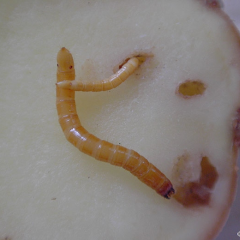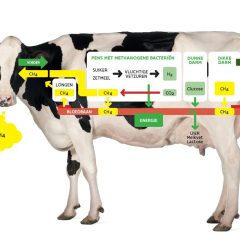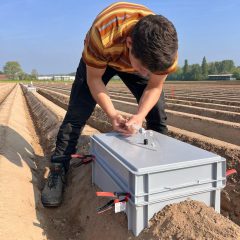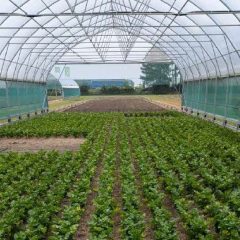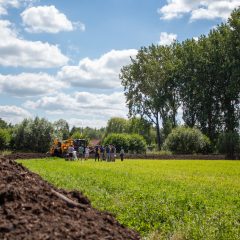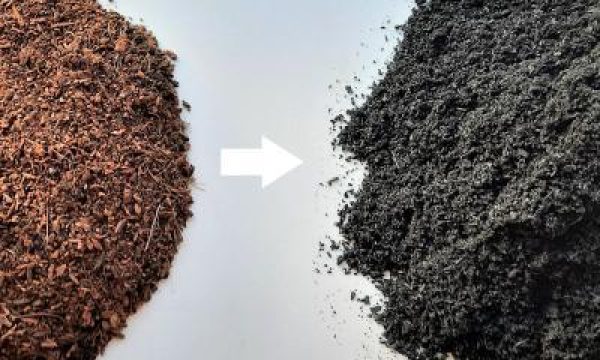Dossier Agroforestry
Agroforestry is a land-use system in which the cultivation of agricultural crops or livestock is combined with the production of woody crops, usually trees, on the same plot. But what are the advantages of this? Which trees can you plant and how do you manage them? What is the best way to coordinate the various production elements? And what business models exist for agroforestry?
Website Agroforestry Vlaanderen
What does ILVO do?
-
 ILVO studies the use of trees and crops in agroforestry systems
ILVO studies the use of trees and crops in agroforestry systems -
 ILVO studies the attitude towards agroforestry, chain development and business models for various forms of agroforestry.
ILVO studies the attitude towards agroforestry, chain development and business models for various forms of agroforestry. -
 ILVO studies the impact of agroforestry systems on soil quality, water, climate, biodiversity, and (crop) yield.
ILVO studies the impact of agroforestry systems on soil quality, water, climate, biodiversity, and (crop) yield. -
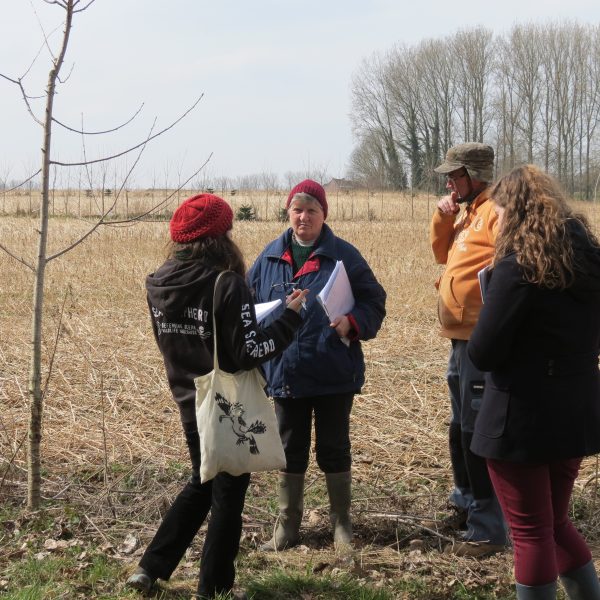 Within the "Consortium Agroforestry Vlaanderen" ILVO gives advice and guidance to farmers with an agroforestry system.
Within the "Consortium Agroforestry Vlaanderen" ILVO gives advice and guidance to farmers with an agroforestry system. -
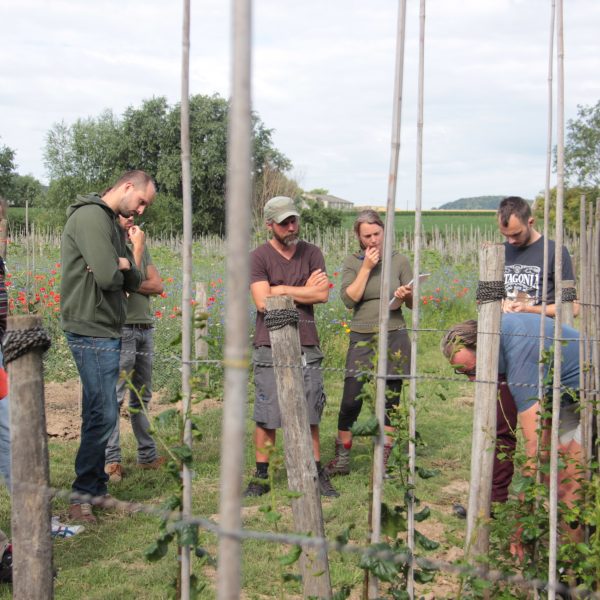 Within the "Consortium Agroforestry Vlaanderen", ILVO co-organizes trainings, master classes, seminars and farm visits.
Within the "Consortium Agroforestry Vlaanderen", ILVO co-organizes trainings, master classes, seminars and farm visits.
Why agroforestry?
Everyone already knows that trees provide a lot of services to society such as:
- Increased biodiversity
- More carbon storage in the soil
- Mitigating the effects of climate change
- Air purification
- Landscape and recreational value
We know from research that they can also be financially or operationally interesting for farmers:
- Erosion protection
- Spreading risk by diversifying revenues
- Creation of a favourable microclimate with functional biodiversity
However, a lot of knowledge is needed in order to enjoy these benefits. Proper tree selection and maintenance of the tree trunks are essential. That is why the Agroforestry Flanders Consortium was founded in 2011.
What does agroforestry look like?
Agroforestry is a fairly broad term. It can take different forms depending on the objective and the farm type. Are you mainly looking for shelter for livestock, woody biomass, fruit yield, or to protect the soil against erosion? A specific type of agroforestry will suit you and your business better depending on your answer to these questions.
- Alley cropping
is planting rows of trees in arable or vegetable plots. Some trees, shrubs, and crops are more suitable for this than others.
Interesting trees and shrubs will comply with these guidelines:
- They offer products (e.g. wood, nuts) for which there is a local market
- Their root systems dig deep and compete minimally with the intermediate crops
- They do not produce chemicals or acidic leaves that force out some of the intermediate crops
And interesting crops include:
- Grain and feed crops
- Fruit, berries, ornamental plants, or aromatic/medicinal plants
- Biomass-producing crops
- Silvo-pastorale systems combine trees and grassland for grazing. The trees provide extra profit in the form of wood, nuts, or fruit, and provide shelter for the grazing livestock against the wind and weather and against predators (e.g. chickens).
However, the trees can also be used as an additional source of food for the animals, who can feed on the leaves, which often contain important minerals and trace elements. Interesting feed trees are willow, alder, ash, and hazel.
- Wood edges and rows of trees are permanent landscape elements for shelter, separation, and greening. The pruning of the wood edges can also be valorized, and both wood edges and rows of trees contribute to soil quality, pollination, and natural pest control on the plot. In turn, these fringe benefits can increase crop yield.
- Food forests are human-designed ecosystems based on the example of a natural forest with a wide variety of (usually perennial) plants in various layers, with the main purpose of producing food.
Business models?
Agroforestry can make farms more robust and less vulnerable to external shocks such as extreme rainfall, drought, or low prices on the global market. This is due to the higher total biomass production (wood and fruit) but also due to the risk spreading. In agroforestry systems, the agricultural component and any expansion of activities (e.g. receiving groups) provides profits in the short term. The wood from the trees (only) provides additional profit in the long term.
Below are some important observations from the research and practical work (for more extensive information, visit www.agroforestryvlaanderen.be (Dutch-French))
- Higher biomass production does not necessarily mean higher financial returns for the farmer, especially when you consider that prices for agricultural crops and wood fluctuate greatly. In addition, the rows of trees take up land and cast shade on the crops, so that the yield near the trees decreases after a number of years. In practice, it is therefore important to make well-considered choices (crop rotation, choice of tree species, number of trees per hectare, choice of plot, etc.) and to take into account the growth and evolution of the planted trees and shrubs over the years. The Agroforestry Flanders Consortium has developed an interactive agroforestry planner (Dutch) to help interested farmers get started.
- The construction of an agroforestry plot should be considered as a long-term investment: the value of the trees (quality wood, fruit) can be harvested within a period ranging from 15 to over 50 years, depending on the tree species. Individual farmers can spread their timber supply over time, by postponing the felling date and sale, thus capitalizing on good or bad timber prices.
- Product diversification can help to spread risk. In agroforestry systems, the agricultural component ensures short-term income, and in the longer term, the timber provides an interesting extra source of income.
- Farms using agroforestry are clearly distinguished from others in terms of landscape, ecology, and economy. Compared to specialized arable and/or livestock farms with a rather limited crop choice, agroforestry offers a more versatile production system while maintaining or improving soil quality, potential savings on pesticide use, etc.
- Forms of expansion and reorientation are becoming increasingly important in Flemish agriculture. This includes activities such as farm tourism, landscape and nature management, home processing, and the sale of farm products. Agroforestry offers opportunities to realize such activities, both on a large scale and at a business level.
Obstacles?
The roll-out of the system in Flemish agriculture has been quite slow over the past decade. Approximately 130 hectares of agroforestry has been added to around 50 farms between 2011, the start of supporting subsidies for agroforestry, and 2019.
Despite the subsidies and the potential pointed out by researchers, most farmers are still hesitant. Doctoral research (in Dutch) by Lieve Borremans (ILVO/ULB, 2019) exposed a number of barriers:
- Lack of profitability certainty (i.e. will I be able to sell the wood from my trees after 15 to 50 years, and at a good price?)
- Adaptability in the business
- Lack of knowledge and competences
- A flawed legal framework
- Few flexible support measures
- Lack of broad support in the agricultural sector
To be continued…
A number of obstacles have been removed in recent years. Nevertheless, a number of challenges still loom large. New business models and a new market instrument to compensate farmers for ecosystem services such as soil carbon storage, for instance, could be a major breakthrough for agroforestry.
Research projects

